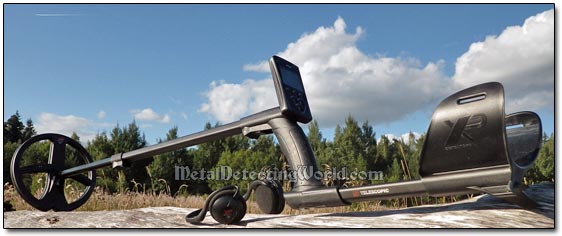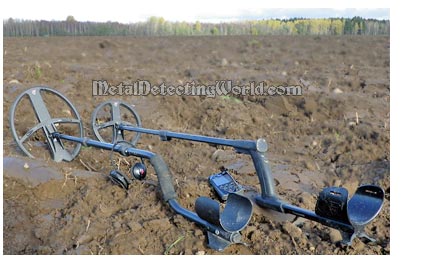Introduction (Must-Read)
The current XP Deus User's Instruction Manual is the XP Metal Detectors' total failure as it does not deliver information in any comprehensible way and lacks necessary explanations of the Deus features and modes, especially how they interact with one another, and what effects combinations of their settings have on the Deus' performance. As I mentioned in my Review on XP Deus, the XP Deus has the highest User-Adjustability among all today's advanced metal detectors, and this is what makes the Deus the most versatile metal detector. But, one must understand that the highest User-Adjustability means not only limitlessness in terms of Target Separation and Target Recogntion, but also complexity in the fine-tuning process. The Deus shines only when it is fine-tuned to the unique metal detecting conditions of EVERY hunt site, types of targets sought, and the user's hearing abilities and preferences.
Obviously, fine-tuning of the Deus is a complicated task for a beginner-user, especially if one has just started metal detecting. But even for an experienced detectorist who has used different metal detectors over years, grasping the Deus' User-Adjustability concept and elaborating an optimal combination of search program settings can be problematic. The principal idea of detecting with the Deus is simple: since the Deus can be attuned relatively to any metal detecting conditions, it is only your own limits that will not let you get most finds out of any metal detecting site. For example, being not willing to climb the learning curve all the way up to the top can be considered putting a limit on oneself. Using the factory preset programs on a regular basis is another limit which the Deus users voluntary impose on themselves.
This is why it is not recommended to use the factory-preset search programs for serious detecting as they are designed for introductory purposes (to be used only for a short duration of time) and as the "foundations" for one's own custom programs. Moreover, it is a proven bad practice to use the customized search programs posted for all on the internet. Such programs have attractive, promising names but, if not modified, do not suit metal detecting conditions other than the conditions of those localities where these programs were created. Do not get me wrong, you can still make many good finds with those programs, but you will never know how many real valuables you would leave behind! However, any "program for all" also can be used as the basis for your customized search program suitable for local levels of mineralization/iron contamination and specific target TYPES.
This explanatory guide will help you understand all ins and outs of the Deus features and modes, climb the very steep learning curve faster, and expand your limits. But, to "cement" your theoretical knowledge, you need do your practical "home work" - experimenting with various program settings and targets in focus at hunt sites you visit. This can be done by using a very effective method - "Depth Penetration Test", which will be described in my upcoming article/tutorial (it will be posted soon).
To have something to start with at home, conduct an Air Test (Bench Test) to get familiar with VDI's of various targets that are typical for YOUR search area, and then use the obtained VDI's for setting optimal Accepting and Rejecting ranges in Discrimination patterns of your custom search programs. If you run the Air Test inside the house or apartment, lower the Sensitivity level to 70 to eliminate interference from electrical wiring and home electronic devices including wireless routers, wireless networking adapters, etc. For determining somewhat appropriate settings of the Target-Separating features, and improve the Deus' Target Recognition ability, construct your own Test Garden.
Even for an experienced treasure hunter who is not familiar with the XP Deus, there may be too much info in this guide to digest quickly. Please do not try to understand everything at once! Follow a simple rule of learning: gradually move from simple to complex. It is best to read and reread every feature's description a few times so that all given information can be fully comprehended, sorted out, and later used to one's advantage. In this guide, all explained basic features and modes are arranged in the same order as they are arranged in a User's Instruction Manual; however, all corresponding Expert settings are placed along with their "parent" features and modes on same pages for convenience. I suggest to make notes on key points right in the user's manual for quick reference when you customize or modify your search program(s) later.
My guide does not cover "How-To's" for assembling the Deus, setting a clock, pairing headphones to new coils, editing search programs, upgrading to a new firmware version, and fast switching between them (actually this subject is covered in my article - How To Fast Switch Between XP Deus Search Programs). This article was neither created to explain why there is a flashing light on a search coil all the time... Oh, well, ok, the light is there because the search coil always stays ON (in a standby mode)!
NOTE:
After the first part of this guide was posted here, new updated firmware versions, v3.0, v3.1, v3.2 and v4.0, were released. The version 3.2, for example, acquired 13 new improvements and some new features in comparison with v2.0. Even though the latest version v4.0 acquired some changes in existing features, and a couple of more additional features, and is supposed to provide better digital signal processing, increased target separation and detection depth in mineralized ground, it still got some bugs in it. Moreover, the v4.0 was released to serve the white HF search coils which were specially designed for gold nugget and meteorite hunting. Therefore I would not urge you to upgrade to the v4.X, especially if you have used the version v3.2 for a while, feel comfortable with it, and are satisfied with results. Same goes for the version v2.0 which is still considered the best in providing the most Detection Depth.


